Caution: VERY LONG!
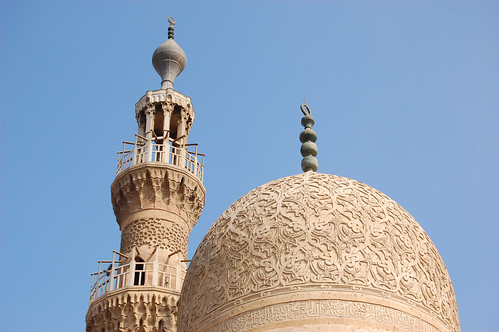 Being a muslim country, Egypt in general has many mosques. Cairo itself has a population of around 16 million and a majority of them muslims, residing in a dense area of only 457 square kilometers, so you would have to expect Cairo to have A LOT of mosques. Due to the extreme density of the city, dont expect to find mosques with sprawling gardens and huge carparks like you do in Malaysia, though. Most mosques are found tucked away on narrow streets (some are more like lanes that could fit only one moving car), in a maze of packed buildings. Some are not even reachable by vehicles with more than 2 wheels. Despite this, I found the sudden discovery of an old mosque during our random walks to be quite pleasant, even if we dont know its name or get a chance to go in.
Being a muslim country, Egypt in general has many mosques. Cairo itself has a population of around 16 million and a majority of them muslims, residing in a dense area of only 457 square kilometers, so you would have to expect Cairo to have A LOT of mosques. Due to the extreme density of the city, dont expect to find mosques with sprawling gardens and huge carparks like you do in Malaysia, though. Most mosques are found tucked away on narrow streets (some are more like lanes that could fit only one moving car), in a maze of packed buildings. Some are not even reachable by vehicles with more than 2 wheels. Despite this, I found the sudden discovery of an old mosque during our random walks to be quite pleasant, even if we dont know its name or get a chance to go in.
Muslims have been building mosques in Egypt since their conquest of the country in 641AD, with the most number and the most architecturally luxurious ones being built between 1250 to 1517, during the Mamluk era. One of the largest and oldest mosques in the country is the mudbrick Mosque of Ibnu Tulun, which was built AD876 and AD879 by an Abbasid governor sent from Baghdad to rule Egypt. Unfortunately I did not get to visit this mosque.
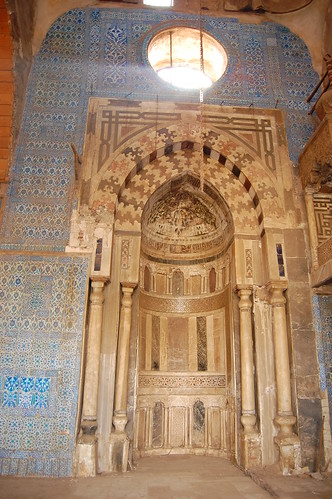 One of the first mosques we visited was the Aqsunqur Mosque, which is also known as The Blue Mosque. It was built on 1347 AD by Prince Aqsunqur Al-Nassery, but decorated by Ibrahim Aga Mustahfazan, who put blue floral tilework on the walls facing east (the direction of the kiblat). There are only 3 mosques decorated in this manner and they are all called "Blue Mosques". One is in Istanbul, Turkey and the other is in Isfahan, Iran. In this mosques lies the tomb of Prince Aqsunqur and of Ibrahim Aga.
One of the first mosques we visited was the Aqsunqur Mosque, which is also known as The Blue Mosque. It was built on 1347 AD by Prince Aqsunqur Al-Nassery, but decorated by Ibrahim Aga Mustahfazan, who put blue floral tilework on the walls facing east (the direction of the kiblat). There are only 3 mosques decorated in this manner and they are all called "Blue Mosques". One is in Istanbul, Turkey and the other is in Isfahan, Iran. In this mosques lies the tomb of Prince Aqsunqur and of Ibrahim Aga.
This mosque is currently unused after it was damaged in an earthquake and is under restoration. Even in its derelict condition though, you still can catch a glimpse of its past glory by looking at the marbeled mihrab (the carved out niche that shows the direction of Kaa'bah) and the intricately carved mimbar (an elevated podium where the imam would give his sermon). There are still magnificent blue tiles on the east walls and you could still see the floral painted decorations on the wooden rafters.
The custodian of the mosque invited us to go up one of the minarets and even helped to carry Izani. The winding stair going up was narrow and pitch dark at certain parts (we had to feel our way buy holding on to the walls and stepping very very carefully), and the climb was quite strenuous (my disused leg musles ached for two days after!) perhaps due to me being extra tense and cautious in the dark, but the view that we got at the top was all worth it. From the minaret, we could see almost all of Cairo. Even though it was quite a hazy day, we still could see the bluish gleaming domes of the Mohamed Ali Mosque in the Citadel on top of the hill in the distance.
The custodian was very helpful and informative so we gave him a tip, which in restrospect, is probably less than what he truly deserved, but who goes back to a site just to give the custodian more money? Perhaps next time, eh?

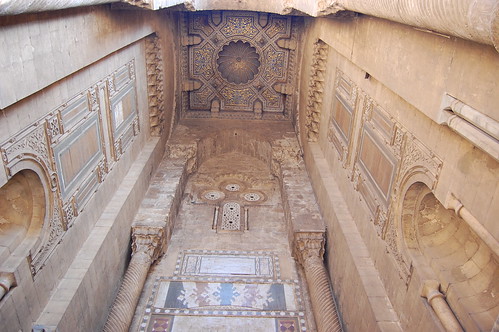
The above is
Sultan Hassan Mosque and
Ar-Rifaie Mosque, respectively. They are located right next to each other, seperated only by a pedesterian street that felt almost like a canyon due to the high walls of the mosques on each side.
Sultan Hassan Mosque is 450years older than Ar-Rifaie, built in 1356, by the renownly greedy Sultan An-Nasr Hassan who used the money from the estates of people who had died from some kind of plague called 'Black Death' in 1348 to fund it. Sultan An-Nasr Hassan was murdered 2 years before the mosque's completion in 1363. His body was never recovered and therefore is not laid to rest in his own mosque.
Ar-Rifaie mosque, however, is filled with glitzy tombs of members of the royal family, including Khedive Ismail and King Farouk, the last king of Egypt. Also buried here is the last Shah of Iran. To enter Ar-Rifaie mosque, you'd have to climb a steep set of stairs. Izani was asleep and my legs were still hurting from climbing the Aqsunqur minaret, so I did not see what it looked like inside.
We also did not go into Sultan Hassan Mosque because they were preparing for Friday prayers and we had wanted to perform ours in the Citadel.

The jewel on cairo's crown must be the
Mohammed Ali Mosque, which was built in 1830 by Mohammed Ali Pasha, most regarded as the founder of modern Egypt.
Though not a distinct example of Islamic architecture, it is one of the most famous tourist spots in Cairo, perhaps due to it being located in The Citadel (Al-Qalaa, as it is also known), a fort that was built by the famed muslim commander Salah ad-Din on top of one of the hills on the east side of Cairo. From the fort you could see almost the whole of Cairo to your west, and some people say that on a clear day, you could even see the pyramids (too bad it was hazy when we were there).
On the west wall of the mosque's courtyard stands an ornate clock, a gift from King Louis-Phillipe of France, in exchange for the obelisk that now stands in the Place de la Concorde in Paris. The clock was damaged upon delivery and still does not work!
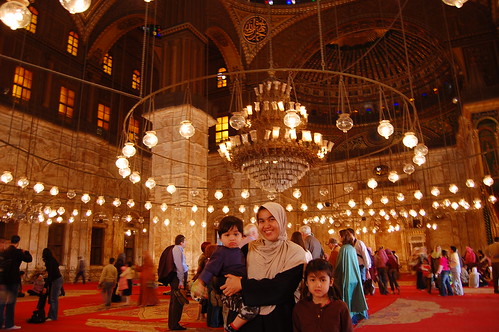
Even though the mosque's floor plan was designed to imitate the Mosque of Sultan Ahmad in Istanbul (the capitol of the Ottoman empire at that time), the decorations inside the dome (apart from the hanging lights) gave me more of a french/italian cathedral feel, with gilded carvings in abundance.
Mohammed Ali's marble tomb sits in a wrought iron enclosure in one corner of the mosque and it is pretty resplendant.
The hanging lights were quite beautiful though. I am seriously thinking of having something like that in my home in the future.. perhaps in the bedroom? *wink*
The lighting in the mosque is quite dark though, and since we're still not experts at taking pictures with the D40, some pictures turned out to be quite blurr. Good thing we took lots of pictures so at least a few were usable.
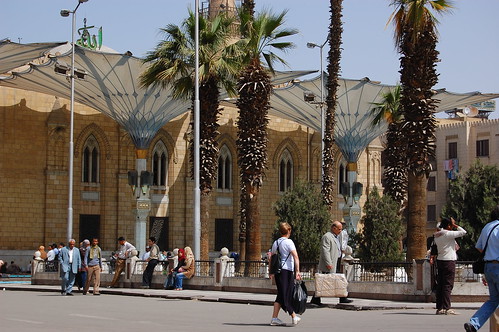
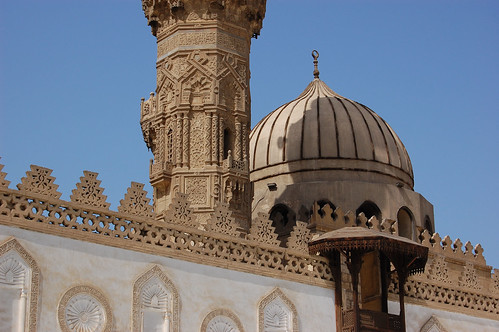
In the area called Islamic Cairo, sitting across Sharia Al-Azhar from each other are the Mosque of Sayyidina al-Hussein and Mosque of Al-Azhar.
Mosque of Sayyidina al-Hussein is considered one of the most important mosques in all Egypt, because it shelters (what the Shiites consider as) one of the most important relics of Islam - the head of Sayyidina Al-Hussein, the grandson of the Prophet Muhammad (s.a.w.). Hussein was the son of Sayyidina Ali, the prophet's son-in-law. It was built in 1154AD to receive the head, almost 500 years after Al-hussein died in a battle in Kerbala, Iraq. This mosque has one feature that I did not see in other mosques - three 'inverted umbrellas' that can be opened to provide shade to worshippers especially during Friday prayers, as seen in the picture above. We did not go inside this mosque because we visited it on a Friday and was advised by the tourist police to pray in the Al-Azhar mosque instead because it is less crowded and more woman-friendly.
Mosque of Al-Azhar is also one of the most venerable mosques in Cairo, because it is also a center of learning. Founded in 970AD, it is considered to be one of the oldest universities in the world. It is still considered central to religious and political life in Egypt, with its Sheikh (I guess like a Dean) being the highest religious authority in the land.
When we were there for Friday prayers, the streets were lined with police on top of a few truckloads more parked on the side. We asked whether they were expecting anything to happen (perhaps as a reaction to the assault on Gaza?), but they shrugged and said everything was normal, they were just there to make sure Friday prayers run smoothly. Right.
The inside of the mosque was suprisingly cool, even though there were no air conditioning, only fans spinning at the end of a really long pole. I couldnt understand the sermon, but somehow I felt strangely peaceful and tranquil. The woman in a white robe and white scarf that help direct women into available spaces by waving at them to come in and pointing to them where to sit, reminded me so much of my mother. There were many women praying in the ladies section, I was literally squeezed!
As the crowds trickle out of the mosque after Friday prayers you could see muslims of all shapes and sizes, of all features and color. There were also many similarly diverse tourists mingling about outside waiting for the worshippers to leave so that they can go in for a visit.
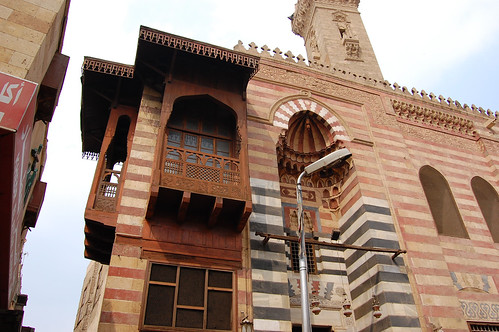
On our random walks in the maze they call 'Khan el Khalili', we discovered the
Mosque of Al-Ashraf Barsbey.
There were stalls selling brass goods and souviners on the alley in front of it, but that didnt take away its beauty. The guidebook says that this mosque was built in 1423, and boasts a beautifully carved wooden pulpit inlaid with ivory. But again, we did not go in, because the entrance has steps (apart from Mohamad Ali's Mosque in Citadel, Hussein's Mosque and Al-Azhar Mosque, I can't seem to recall seeing any mosques that did not have at least 10 steps at the entrance) and Izani was sleeping in his stroller. In front of this mosque is a very interesting shop selling dried spices (hibiscus, cumin, all sorts of roots) and perfume essence. Also displayed prominently were dried starfishes! I have no idea what they are used for and my arabic is limited to ask questions.
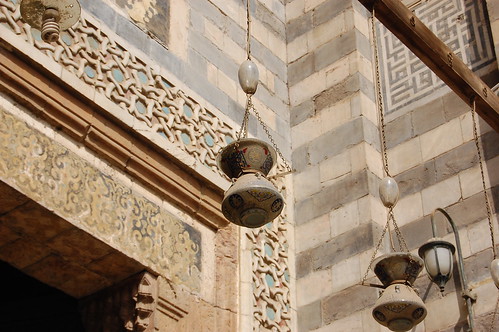
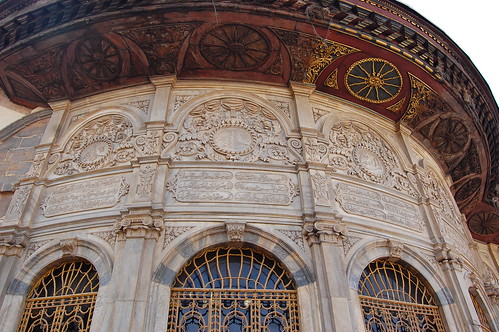
While we were on another walk, another day, this time looking for the Tentmaker's Market (which I will write about in my post about Shopping), we came across Mosque of Sultan Muayyad and Sabil Muhammad Ali Pasha.
Mosque of Sultan Muayyad was built by Sultan al-Malik al-Mu'ayyad Shaykh Abu l-Nasr al-Zahiri al-Mahmudi in 1415. The story that I kept hearing/reading is that Sultan Mu'ayyad was once imprisoned in the dungeon that was once there and he was so miserable that he vowed to demolish the dungeon and built a mosque there if he was ever freed. Obviously, he did :) There is also a madrassa (school) inside. This mosque is just next to
Bab Zuweila (Door/Gate of Zuweila), which is 300 years older than the mosque. In addition to being the platform where the previous sultans would watch the departure of the annual pilgrimage to Mecca, it was also the site of gory public executions. The heads of criminals and slain enemies would be exhibited there, mounted on spikes.
Sabil Muhammad Ali Pasha used to be a public drinking fountain ("Sabil" means "Drinking fountain"). It must one of the most frequently photographed and drawn fountains in Cairo, because you can see pictures/lithographs of it in almost every bookstore and postcard shops. It was built in 1820 by Muhammad Ali Pasha in memory of his son, Tusun Pasha, who died in 1816. It also houses 2 kuttabs (Schools teaching qur'an).
Sabil Muhammad Ali Pasha, Mosque of Sultan Muayyad and Bab Zuweila are all along a street called Sharia al-Muizz li-Din Allah. I would advise you not to miss walking down this street, starting from the Al-Ghouri complex (another nice building/mosque) which is right at the junction with Sharia Al-Azhar ( a very busy main road, so you can get a taxi to get there). The street is very narrow, and is lined with small shops and stalls selling bedlinens and clothes. Ocassionally a small van or scooter might honk you to make way and the street is dusty and uneven (what small street in Cairo is not?), but it is do-able even for families with children. Walking along the street, the sight of colourful hanging clothes would suddenly clear up to reveal the beautiful Sabil Mohammad Ali Pasha. After the sabil, take the street on your left (there are no road signs!) and you will soon see Bab Zuweila and beyond it, the Tentmaker's Market. The street is a little dirty, but just bear with it and distract your attention with the sights and sounds!
Even with the limited number of mosques that I had managed to visit, I still felt like I had just scratched the surface on learning about the wealth and beauty of the old mosques of Cairo. Each mosque, though some with certain similarities, had unique features whether it is in terms of the carvings and decorations in the facade and domes, or in terms of the decorations of its huge doors, lighting fixtures, stained glass windows, tiled walls and mihrabs and elegance of the mimbars.
Just like the carvings on the walls of the ancient egyptian tombs, somebody had taken their time and effort to design, build and decorate these mosques with meticulous detail, attention and love.
Tip: Dress modestly when you want to visit a mosque, because if you dont, you would be forced to wear a ghastly green tent! I would suggest long pants/skirts, with a loose fitting tunic on top (at least 3/4 arm length). Bring a light scarf just in case the custodians ask you to cover your hair. Wear/bring socks because the marble floors can be quite cold. Bring a plastic bag to put your shoes in if you dont want to tip the guy who looks after your shoes.
More (and clearer) pictures on
flickr.



 My prized posession, though, had to be this really tiny sea shell I found. It was so tiny I almost threw it away, but it felt round so I brushed the dirt off to see if it was something worth keeping and was pleasantly suprised to see that it was a shell :)
My prized posession, though, had to be this really tiny sea shell I found. It was so tiny I almost threw it away, but it felt round so I brushed the dirt off to see if it was something worth keeping and was pleasantly suprised to see that it was a shell :)



 Being a muslim country, Egypt in general has many mosques. Cairo itself has a population of around 16 million and a majority of them muslims, residing in a dense area of only 457 square kilometers, so you would have to expect Cairo to have A LOT of mosques. Due to the extreme density of the city, dont expect to find mosques with sprawling gardens and huge carparks like you do in Malaysia, though. Most mosques are found tucked away on narrow streets (some are more like lanes that could fit only one moving car), in a maze of packed buildings. Some are not even reachable by vehicles with more than 2 wheels. Despite this, I found the sudden discovery of an old mosque during our random walks to be quite pleasant, even if we dont know its name or get a chance to go in.
Being a muslim country, Egypt in general has many mosques. Cairo itself has a population of around 16 million and a majority of them muslims, residing in a dense area of only 457 square kilometers, so you would have to expect Cairo to have A LOT of mosques. Due to the extreme density of the city, dont expect to find mosques with sprawling gardens and huge carparks like you do in Malaysia, though. Most mosques are found tucked away on narrow streets (some are more like lanes that could fit only one moving car), in a maze of packed buildings. Some are not even reachable by vehicles with more than 2 wheels. Despite this, I found the sudden discovery of an old mosque during our random walks to be quite pleasant, even if we dont know its name or get a chance to go in. One of the first mosques we visited was the Aqsunqur Mosque, which is also known as The Blue Mosque. It was built on 1347 AD by Prince Aqsunqur Al-Nassery, but decorated by Ibrahim Aga Mustahfazan, who put blue floral tilework on the walls facing east (the direction of the kiblat). There are only 3 mosques decorated in this manner and they are all called "Blue Mosques". One is in Istanbul, Turkey and the other is in Isfahan, Iran. In this mosques lies the tomb of Prince Aqsunqur and of Ibrahim Aga.
One of the first mosques we visited was the Aqsunqur Mosque, which is also known as The Blue Mosque. It was built on 1347 AD by Prince Aqsunqur Al-Nassery, but decorated by Ibrahim Aga Mustahfazan, who put blue floral tilework on the walls facing east (the direction of the kiblat). There are only 3 mosques decorated in this manner and they are all called "Blue Mosques". One is in Istanbul, Turkey and the other is in Isfahan, Iran. In this mosques lies the tomb of Prince Aqsunqur and of Ibrahim Aga.

 The jewel on cairo's crown must be the Mohammed Ali Mosque, which was built in 1830 by Mohammed Ali Pasha, most regarded as the founder of modern Egypt.
The jewel on cairo's crown must be the Mohammed Ali Mosque, which was built in 1830 by Mohammed Ali Pasha, most regarded as the founder of modern Egypt. Even though the mosque's floor plan was designed to imitate the Mosque of Sultan Ahmad in Istanbul (the capitol of the Ottoman empire at that time), the decorations inside the dome (apart from the hanging lights) gave me more of a french/italian cathedral feel, with gilded carvings in abundance.
Even though the mosque's floor plan was designed to imitate the Mosque of Sultan Ahmad in Istanbul (the capitol of the Ottoman empire at that time), the decorations inside the dome (apart from the hanging lights) gave me more of a french/italian cathedral feel, with gilded carvings in abundance. 




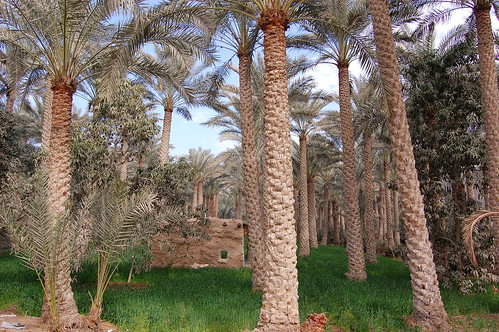
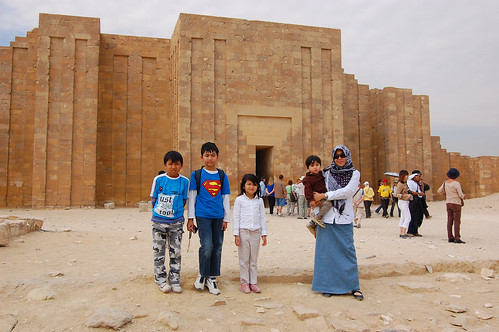 Saqqara is one of the richest archaeological sites in egypt, being 3000 years old. We were greeted by the limestone wall that hides a colonnaded corridor of 40 pillars, ribbed in imitation of palm stems. The walkway is longer than I thought it would be, but it is very narrow and on a busy day (like the one when we were there), be prepared to rub shoulders with other tourists. When there are less people though, do take a chance to
Saqqara is one of the richest archaeological sites in egypt, being 3000 years old. We were greeted by the limestone wall that hides a colonnaded corridor of 40 pillars, ribbed in imitation of palm stems. The walkway is longer than I thought it would be, but it is very narrow and on a busy day (like the one when we were there), be prepared to rub shoulders with other tourists. When there are less people though, do take a chance to 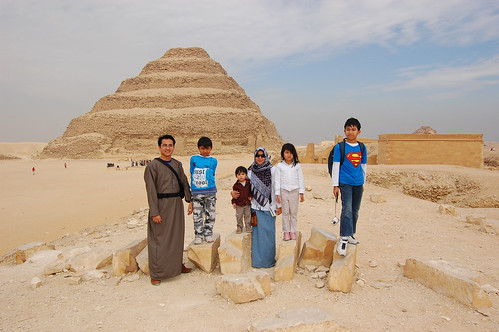
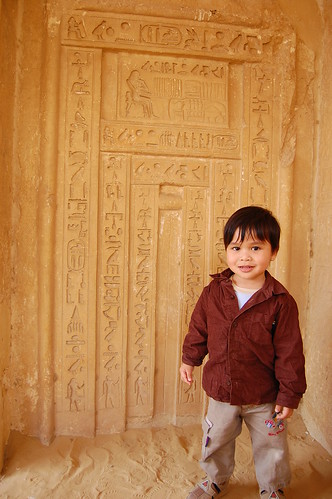
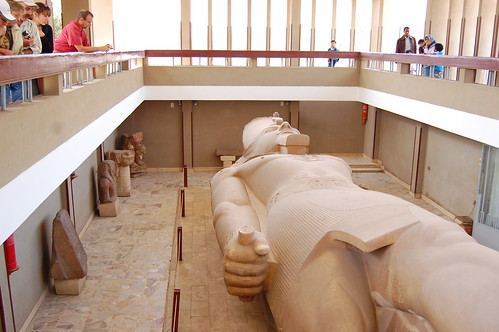
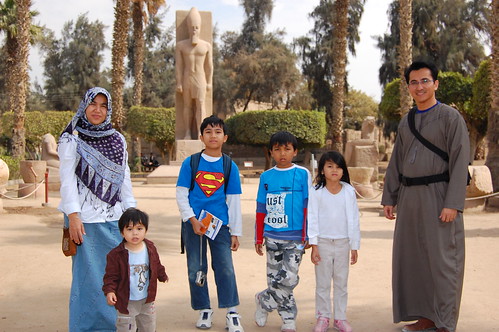
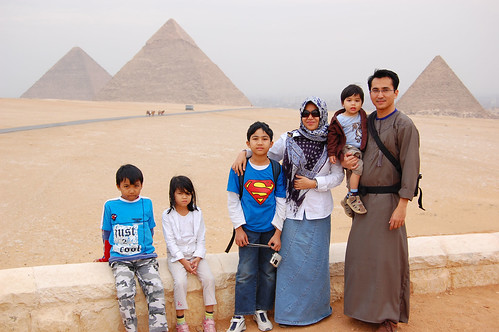


 Our hotel was right smack in the middle of central cairo.
Our hotel was right smack in the middle of central cairo. My kid's favourite part of the hotel is the open-shaft elevator. They like pulling at the grilled doors and help the bellboy with the lever controls. When they're not in the elevator, they look at the exposed pulleys and chains and wave at the people inside the elevator. They keep asking me what does "Appel" mean on the button that we have to press to buzz for the elevator. Their favourite bit of the day is when half of us would ride the elevator (it could only fit 4 people at a time) and the rest (usually Ilham and Ihsan) would wait till the bellboy says "Go!" and they would race down/up the stairs that winds around the elevator to see who reaches the lobby/room first.
My kid's favourite part of the hotel is the open-shaft elevator. They like pulling at the grilled doors and help the bellboy with the lever controls. When they're not in the elevator, they look at the exposed pulleys and chains and wave at the people inside the elevator. They keep asking me what does "Appel" mean on the button that we have to press to buzz for the elevator. Their favourite bit of the day is when half of us would ride the elevator (it could only fit 4 people at a time) and the rest (usually Ilham and Ihsan) would wait till the bellboy says "Go!" and they would race down/up the stairs that winds around the elevator to see who reaches the lobby/room first. It all started with Anis on the very first day we arrived in Cairo. She started spewing chunks and kept going to the bathroom. I thought maybe it was because she was really slow at eating lunch before we left and that she didnt chew her chicken properly, but when it went on for 2 days and she kept dozing off and being lethargic, I started to worry. We got her some anti-vomitting medicine from the nearest pharmacy and she got better.
It all started with Anis on the very first day we arrived in Cairo. She started spewing chunks and kept going to the bathroom. I thought maybe it was because she was really slow at eating lunch before we left and that she didnt chew her chicken properly, but when it went on for 2 days and she kept dozing off and being lethargic, I started to worry. We got her some anti-vomitting medicine from the nearest pharmacy and she got better.

